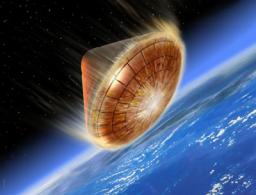The one thing between astronauts and temperatures hot enough to melt, if not boil, many metals, is the heat shield. The slightest flaw in the heat shield can cause the shuttle to explode as was seen with Space Shuttle Colombia in early 2003. So what makes a good heat shield? First of all, surface area. A large surface area is wanted during reentry so minimize speed and maximize heat dispersion. This is why early astronauts returned blunt side forward in their capsule and why space shuttles today return bottom side first rather than nose first.
Early heat shields used a method called ablation. Ablation involves parts of the heat shield to melt or vaporize and break off causing heat to go with these parts, thus, reducing the heat on the the returning capsule. Modern day heat shields are much more sophisticated and dissipate heat rather than ablate it.
“The Shuttle’s thermal tiles come in three materials and two colors, are 2.5-7.5 cm thick, and cover most of the Orbiter’s undercarriage and wings. All three materials are composites made mostly of silica fiber with various additives, heat-treated in a way similar to firing ceramics. They can be coated with either white or black glass. White tiles can be used in areas where the temperature does not exceed 650°C, black tiles where it does not exceed 1,260°C. The leading edges of the Shuttle, which get hottest during reentry, are protected by panels made of reinforced carbon-carbon (RCC) that are fixed to the vessel’s structural skeleton by floating joints to allow for differences in thermal expansion. The RCC panels can tolerate a maximum temperature of 1,630°C.” (http://www.daviddarling.info/encyclopedia/R/reentry_thermal_protection.html)

http://www.erkenntnishorizont.de/images/raumfahrt/reentrydemo.jpg